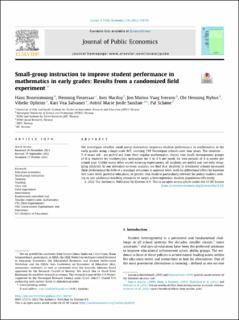| dc.contributor.author | Bonesrønning, Hans | |
| dc.contributor.author | Finseraas, Henning | |
| dc.contributor.author | Hardoy, Ines | |
| dc.contributor.author | Iversen, Jon Marius Vaag | |
| dc.contributor.author | Nyhus, Ole Henning | |
| dc.contributor.author | Opheim, Vibeke | |
| dc.contributor.author | Salvanes, Kari Vea | |
| dc.contributor.author | Sandsør, Astrid Marie Jorde | |
| dc.contributor.author | Schøne, Pål | |
| dc.date.accessioned | 2022-11-17T12:56:43Z | |
| dc.date.available | 2022-11-17T12:56:43Z | |
| dc.date.created | 2022-11-10T13:22:20Z | |
| dc.date.issued | 2022 | |
| dc.identifier.citation | Journal of Public Economics. 2022, 216 . | |
| dc.identifier.issn | 0047-2727 | |
| dc.identifier.uri | https://hdl.handle.net/11250/3032459 | |
| dc.description.abstract | We investigate whether small-group instruction improves student performance in mathematics in the early grades using a large-scale RCT covering 159 Norwegian schools over four years. The students − 7–9 years old - are pulled out from their regular mathematics classes into small, homogenous groups of 4–6 students for mathematics instruction for 3 to 4 h per week, for two periods of 4–6 weeks per school year. Unlike many other recent tutoring experiments, all students are pulled out, not only struggling students. In our intention-to-treat analysis, we find that students in treatment schools increased their performance by 0.06 of a standard deviation in national tests, with no differential effect by baseline test score level, parental education, or gender. Our study is particularly relevant for policy-makers seeking to use additional teaching resources to target a heterogeneous student population efficiently. | |
| dc.language.iso | eng | |
| dc.title | Small-Group Instruction to Improve Student Performance in Mathematics in Early Grades: Results from a Randomized Field Experiment | |
| dc.title.alternative | Small-Group Instruction to Improve Student Performance in Mathematics in Early Grades: Results from a Randomized Field Experiment | |
| dc.type | Peer reviewed | |
| dc.type | Journal article | |
| dc.description.version | publishedVersion | |
| dc.description.version | publishedVersion | |
| dc.source.pagenumber | 8 | |
| dc.source.volume | 216 | |
| dc.source.journal | Journal of Public Economics | |
| dc.identifier.doi | 10.1016/j.jpubeco.2022.104765 | |
| dc.identifier.cristin | 2071863 | |
| dc.relation.project | Norges forskningsråd: 256217 | |
| cristin.ispublished | true | |
| cristin.fulltext | original | |
| cristin.fulltext | original | |
| cristin.qualitycode | 2 | |
